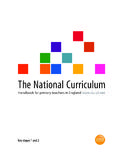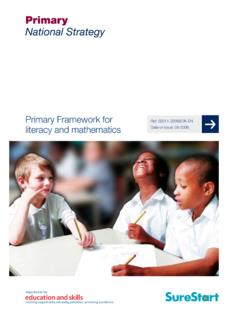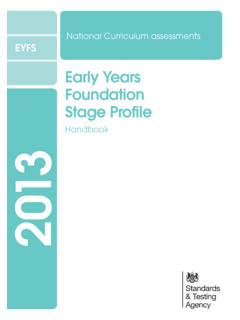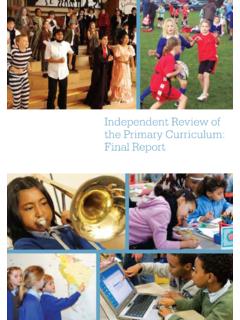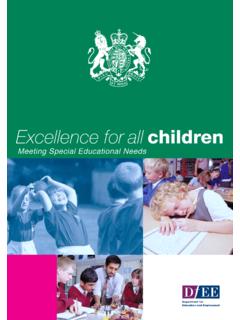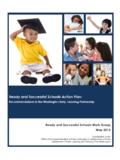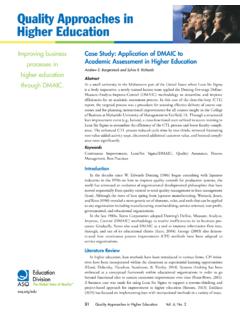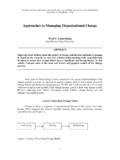Transcription of Statutory Framework for the Early Years …
1 1 Statutory Framework for the Early Years Foundation stage Setting the standards for learning , development and care for children from birth to five 1 Contents Introduction 2 Section 1 - The learning and development requirements 4 Section 2 - Assessment 10 Section 3 - The safeguarding and welfare requirements 13 This Framework is mandatory for all Early Years providers (from 1 September 2012)1: maintained schools, non-maintained schools, independent schools, and all providers on the Early Years Register2. The learning and development requirements are given legal force by an Order made under Section 39(1)(a) of the Childcare Act 2006. The safeguarding and welfare requirements are given legal force by Regulations made under Section 39(1)(b) of the Childcare Act 2006.
2 Ofsted has regard to the Early Years Foundation stage (EYFS) in carrying out inspections, and reports on the quality and standards of provision. Ofsted publishes inspection reports at Ofsted may issue a notice to improve (in respect of any failure to meet a requirement in the document), and/or may issue a welfare requirements notice (in respect of Section 3). It is an offence for a provider to fail to comply with a welfare requirements notice. 1 Section 46 of the Childcare Act 2006 enables the Secretary of State to confer exemptions from the learning and development requirements in certain prescribed circumstances. 2 The Childcare (Exemptions from Registration) Order 2008 ( ) specifies the circumstances in which providers are not required to register.
3 2 Introduction I. Every child deserves the best possible start in life and the support that enables them to fulfil their potential. Children develop quickly in the Early Years and a child s experiences between birth and age five have a major impact on their future life chances. A secure, safe and happy childhood is important in its own right. Good parenting and high quality Early learning together provide the foundation children need to make the most of their abilities and talents as they grow up. II. The Early Years Foundation stage (EYFS) sets the standards that all Early Years providers must meet to ensure that children learn and develop well and are kept healthy and safe. It promotes teaching and learning to ensure children s school readiness and gives children the broad range of knowledge and skills that provide the right foundation for good future progress through school and life.
4 III. The EYFS seeks to provide: quality and consistency in all Early Years settings, so that every child makes good progress and no child gets left behind; a secure foundation through learning and development opportunities which are planned around the needs and interests of each individual child and are assessed and reviewed regularly; partnership working between practitioners and with parents and/or carers; equality of opportunity and anti-discriminatory practice, ensuring that every child is included and supported. IV. The EYFS specifies requirements for learning and development and for safeguarding children and promoting their welfare. The learning and development requirements cover: the areas of learning and development which must shape activities and experiences (educational programmes) for children in all Early Years settings; the Early learning goals that providers must help children work towards (the knowledge, skills and understanding children should have at the end of the academic year in which they turn five); and assessment arrangements for measuring progress (and requirements for reporting to parents and/or carers).
5 3 V. The safeguarding and welfare requirements cover the steps that providers must take to keep children safe and promote their welfare. Overarching principles VI. Four guiding principles should shape practice in Early Years settings. These are: every child is a unique child, who is constantly learning and can be resilient, capable, confident and self-assured; children learn to be strong and independent through positive relationships; children learn and develop well in enabling environments, in which their experiences respond to their individual needs and there is a strong partnership between practitioners and parents and/or carers; and children develop and learn in different ways and at different rates. The Framework covers the education and care of all children in Early Years provision, including children with special educational needs and disabilities.
6 4 Section 1 The learning And Development Requirements This section defines what providers must do, working in partnership with parents and/or carers, to promote the learning and development of all children in their care, and to ensure they are ready for school. The learning and development requirements are informed by the best available evidence on how children learn and reflect the broad range of skills, knowledge and attitudes children need as foundations for good future progress. Early Years providers must guide the development of children s capabilities with a view to ensuring that children in their care complete the EYFS ready to benefit fully from the opportunities ahead of them. The EYFS learning and development requirements comprise: the seven areas of learning and development and the educational programmes (described below); the Early learning goals, which summarise the knowledge, skills and understanding that all young children should have gained by the end of the Reception year ; and the assessment requirements (when and how practitioners must assess children s achievements, and when and how they should discuss children s progress with parents and/or carers).
7 Wrap around and holiday providers Wrap around3 and holiday providers4 should be guided by, but do not necessarily need to meet, all the learning and development requirements. Practitioners should discuss with parents and/or carers (and other practitioners and providers as appropriate) the support they intend to offer, seeking to complement learning in settings in which children spend more time. The areas of learning and development There are seven areas of learning and development that must shape educational programmes in Early Years settings. All areas of learning and development are important and inter-connected. Three areas are particularly crucial for igniting children s curiosity and enthusiasm for learning , and for building their capacity to learn, form relationships and thrive.
8 These three areas, the prime areas, are: communication and language; physical development; and 3 Care offered before and after a school day, by an after school club or by a childminder. 4 Provision exclusively in the school holidays. 5 personal, social and emotional development. Providers must also support children in four specific areas, through which the three prime areas are strengthened and applied. The specific areas are: literacy; mathematics; understanding the world; and expressive arts and design. Educational programmes must involve activities and experiences for children, as follows. Communication and language development involves giving children opportunities to experience a rich language environment; to develop their confidence and skills in expressing themselves; and to speak and listen in a range of situations.
9 Physical development involves providing opportunities for young children to be active and interactive; and to develop their co-ordination, control, and movement. Children must also be helped to understand the importance of physical activity, and to make healthy choices in relation to food. Personal, social and emotional development involves helping children to develop a positive sense of themselves, and others; to form positive relationships and develop respect for others; to develop social skills and learn how to manage their feelings; to understand appropriate behaviour in groups; and to have confidence in their own abilities. Literacy development involves encouraging children to link sounds and letters and to begin to read and write. Children must be given access to a wide range of reading materials (books, poems, and other written materials) to ignite their interest.
10 Mathematics involves providing children with opportunities to develop and improve their skills in counting, understanding and using numbers, calculating simple addition and subtraction problems; and to describe shapes, spaces, and measures. Understanding the world involves guiding children to make sense of their physical world and their community through opportunities to explore, observe and find out about people, places, technology and the environment. Expressive arts and design involves enabling children to explore and play with a wide range of media and materials, as well as providing opportunities and encouragement for sharing their thoughts, ideas and feelings through a variety of activities in art, music, movement, dance, role-play, and design and technology.
